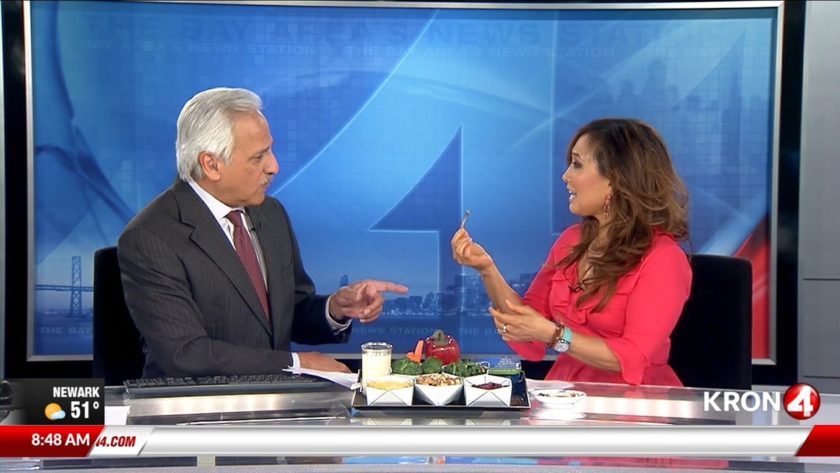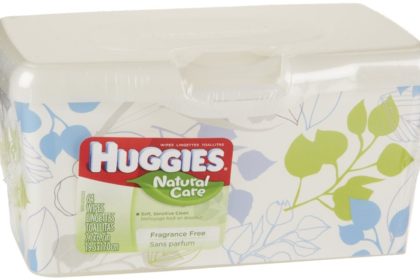UPDATE: See how certain types of food can soften a chicken bone — just like your enamel. Your toothless grin at six may have been cute back then, but as an adult, it’s not so adorable. Check out my ‘chicken bone experiment’ to demonstrate dental health to Marty Gonzalez, anchor of KRON 4 Weekend News. We all know that candy and sweets aren’t good for your teeth, but preventing tooth decay and preserving your aging teeth involve more than what NOT to eat…
Enamel Enemy No. 1
Your enamel is the hard outer layer on your teeth that protects them from harmful acids. Your teeth are covered with a sticky film of bacteria called plaque. When sugars from the food you eat/drink mix together with plaque, acid is formed.
SUGAR + PLAQUE = ACID
- Acids attack your teeth. Repeated attacks can cause the tooth enamel to break down (soften) which can lead to cavities. When acid levels in your mouth drop below 5.5 on the pH scale, tooth enamel begins to be destroyed.
- On the pH scale (a measure of acidity in chemistry), 1 is a strong acid and 7 is neutral.
Coca-Cola is More Acidic than Vinegar
Everyday food and drinks contain varying amounts of acid and sugar (an acid producer). Acids dissolve the calcium and minerals out of bones to make them soft. Similarly, the acids that attack your teeth can erode your enamel (by removing minerals from the enamel) making them susceptible to wear, pain and decay.
pH levels of the following drinks:
- Water = 7 (neutral)
- Milk = 6.8
- Fruit juices = 3.3 to 3.8
- Vinegar = 2.9
- Coca-Cola = 2.5 (with 9 1/3 teaspoons of added sugar in a 12-oz. can)
Foods that Build Strong Teeth
 Foods that contain bone-building vitamins and minerals (e.g., magnesium, calcium, and vitamin D) will help you preserve your aging teeth.
Foods that contain bone-building vitamins and minerals (e.g., magnesium, calcium, and vitamin D) will help you preserve your aging teeth.
1. Magnesium
Magnesium is an especially important mineral in strengthening aging teeth and bones, so include plenty of:
- Nuts, nut butters, seeds
- Dried beans, lentils, whole grains
- Green leafy vegetables. dried fruits
2. Calcium and Vitamin D
In general, dairy products are good sources, but non-dairy foods are also excellent sources of bone-building calcium. They include:
- Tofu
- Sardines
- Shrimp
- Broccoli
- Dark-green leafy green vegetables (e.g., kale, spinach, arugula, basil)

Pairings that Neutralize Acids
Foods that increase saliva production and neutralize acids will help keep your teeth healthy and strong. Pair acids in the following ways…
Pair Veggies with Acids
These fibrous foods act like little toothbrushes, increase saliva production, and increase chewing which helps to keep your teeth and gums healthy. Add crunchy vegetables to your vinegar-based (acidic) salads, such as:
- Bell peppers
- Broccoli
- Carrots
- Cauliflower
- Celery
- Cucumbers
- Radishes
- Tinkerbell peppers
Pair Nuts with Acids (also a source of magnesium)
- Pair nuts or nut butters, such as Nuttzo Organic Crunchy 7 Nut and Seed Butter or Santa Cruz Peanut Butter (low in sodium) with sugary foods to increase saliva production and reduce the effects of the acid on your enamel.
- Add nuts to your salads if they’re dressed with vinegar-based dressings. Good choices include walnuts which are high in heart-protective omega-3 fats and almonds. Be careful when chomping down on whole almonds though as they can fracture fragile teeth.
Pair Cream/Yogurt with Acids
- Fruit juices are very concentrated sources of acid.
- By adding some unsweetened plain yogurt to your fruit smoothie, you’ll neutralize some of the acid and end up with a tasty smoothie.
Pair Cheese with Acids
- Cheese is the ideal antidote for sugar as it neutralizes acid, and the calcium helps restore minerals (calcium) to your teeth.
- Wine is acidic and strikes a balance with cheese. The pair is perfect for both your palate as well as your teeth.’
Pair Milk with Acids
- Sugary sweets like candy, muffins, and desserts contribute to enamel erosion due to their acidic sugar and worse yet, they tend to be sticky and gooey, so they cling to your teeth.
- By washing down yours sweets with milk, you can reduce the acidity in these foods and help restore minerals (calcium) to your teeth.
How to Drink Acids
- If you drink acidic drinks (soda, iced tea or water with lemon), drink them through a straw to minimize contact with your enamel.
- Sodas contain phosphoric acid to give them a sharper flavor and prevent mold and bacteria growth.
- Phosphoric acid is more acidic than lemon juice and vinegar and often used for rust removal.
Karen’s Fit Tip: Since acids soften enamel, don’t brush right after eating acids. You may have been raised to “brush after every meal”, but this is where you can relax that rule a bit. The abrasiveness of brushing when your enamel is ‘soft’ can further damage your enamel. Instead, rinse with tap water to wash away some of the acid, then wait at least 30-60 minutes before brushing. Saliva helps to restore the pH balance.







